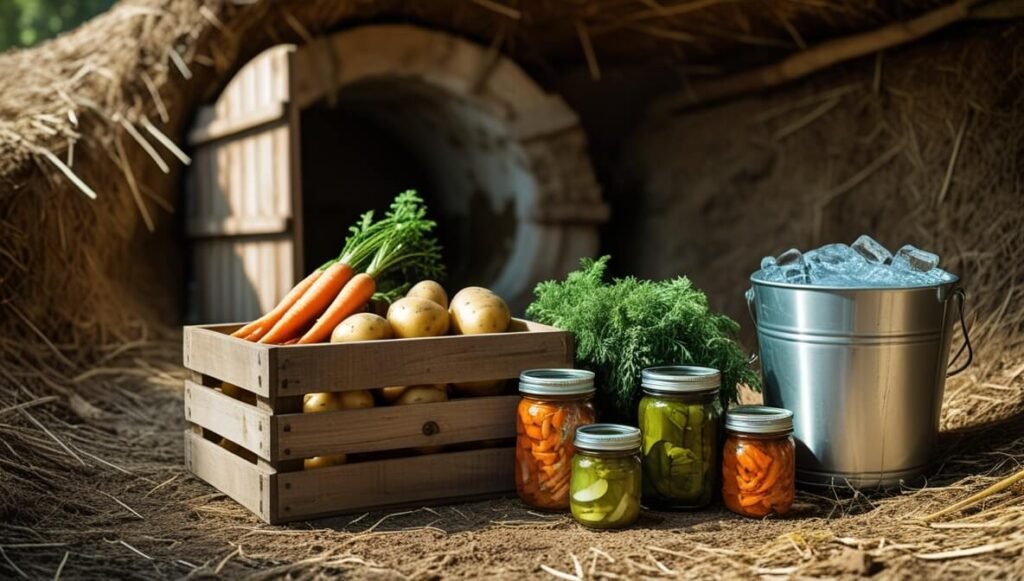Modern life depends so heavily on electricity that many people have forgotten how to preserve food the old-fashioned way. But if the grid goes down, whether due to a storm, blackout, cyberattack, or societal collapse, keeping perishable food safe becomes a serious challenge. In a long-term crisis, refrigeration is no longer a convenience; it’s a survival skill. That’s why learning how to keep food cold without electricity is essential for every prepper, homesteader, or anyone who wants to be self-reliant.
In this article, we explore effective methods that don’t require power, including both low-tech DIY setups and traditional practices used long before refrigeration existed.

*Some resources in article are affiliate links. Full disclosure here.
Why It Matters: Food Safety and Spoilage
Perishable foods like meat, dairy, and leftovers must be kept below 40°F (4°C) to prevent bacterial growth and food-borne illness. In survival situations, keeping food cool extends shelf life and reduces waste especially when food may be scarce. Understanding which foods need refrigeration and how long they last is the first step toward managing off-grid food storage.
10 Smart Methods to Keep Food Cold Without Electricity
1. Zeer Pot (Clay Pot Fridge)
A classic solution from hot, arid regions. Place a small unglazed clay pot inside a larger one, fill the gap with sand, and keep it moist. The evaporative cooling can keep contents 20–30°F cooler than the outside temperature. Cover with a wet cloth and keep in a breezy, shaded spot.
2. Bury a Cold Pit or Earth Fridge
Dig a pit 2 to 4 feet deep where the soil stays cool. Line it with straw or sawdust for insulation and moisture control, and cover with a wood or stone lid. For bonus protection, place items in sealed containers. Works especially well in cooler climates.
- PRESERVE FRESHNESS AND FLAVOR: This airtight pet food container helps your pet’s dry food to stay tasty with its Gamma S…
- PROTECT FROM PESTS: The sealed lid of this dog food container locks in flavor and pet food smells while keeping out pest…
- SAFE AND DURABLE STORAGE: Made from food-grade HDPE plastic, this dog food storage container with a 50 lbs capacity prov…
3. Use an Underground Root Cellar
A more permanent version of the cold pit. Traditional root cellars maintain stable temperatures year-round. You can repurpose an old fridge buried in the ground or dig out a ventilated chamber under a shed or hillside. This is ideal for storing fruits, vegetables, and fermenting foods.
This book will walk anyone through the process of building and using a root cellar to store their fruits and vegetables for later use, through the cold winter months when even the most basic items can cost an arm and a leg.
4. Charcoal or Coal Cooler
Build a wooden frame with charcoal-filled walls, kept damp with regular water spray. As the water evaporates from the charcoal, it cools the interior space. Simple and sustainable, this method is great for dry climates and can lower temps significantly with airflow.
5. Spring Box or Stream Fridge
If you’re lucky enough to live near a cold stream or spring, take advantage. Place sealed containers in flowing water and anchor them to avoid loss. Even bottles of milk or bags of vegetables can stay fresh for days in stream-cooled setups.
6. Evaporative Cooling Cabinet (Swamp Fridge)
Line a wooden or metal frame with wet burlap or cotton cloth and place your food inside on shelves. With good airflow and a little shade, this creates a cool zone inside. You’ll need to regularly re-wet the fabric to keep the system working efficiently.
7. Icebox Revival
Still have winter ice or access to a lake? Old-fashioned iceboxes used sawdust-insulated chambers to store large ice blocks and chill food inside. Modern preppers can replicate this using coolers with thick insulation and manually harvested ice.
- ICE RETENTION: TempLock insulation keeps drinks ice cold
- PORTABLE: Recessed wheels and a retractable handle with comfort grip make it easy to move
- DRINKS FOR ALL: Holds up to 47 cans with 30 lbs. of ice
8. Shade + Wet Towel Wrap
A simple and short-term solution. Wrap jars or containers in wet fabric, keep them in the shade, and re-dampen as needed. Works well for small quantities of food like butter or fruit and extends freshness during temporary outages.
9. Build an Ice House (Long-Term Cold Storage)
For serious preppers, consider building an underground or partially buried insulated chamber for ice storage. Ice can be harvested during winter and kept cold for months with enough insulation (like sawdust, straw, or foam panels). This can feed an icebox system all summer.
10. Use Ceramic Water Filters to Cool Bottles
Not just for clean drinking water, ceramic filters can cool the water inside via evaporation if left exposed to air. Store glass bottles of liquids next to or inside filter systems as a passive cooling trick, especially helpful for small-scale needs.
- NATURAL & UNGLAZED: Our mud jug set is made of whole natural unglazed terracotta. Completely natural and safe, 100% eco-…
- SELF-COOLER & TASTE BALANCER: This is a revolutionary self-cooling water bottle that makes the water inside cooler. The …
- HANDMADE & HIGH-QUALITY: These earthen pottery jugs have been delicately handcrafted from high-quality terracotta in the…
Conclusion
Electricity isn’t guaranteed and food safety shouldn’t rely on it. By learning how to keep food cold without electricity, you gain independence, resilience, and peace of mind. Whether you live off-grid, practice prepping, or just want to be ready for a blackout, these techniques can help preserve your food, prevent spoilage, and keep your household running smoothly in uncertain times.








